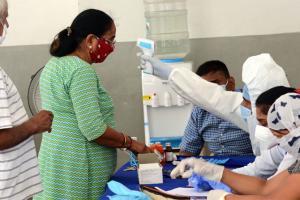
This picture has been used for representational purpose only
Researchers, including one of Indian-origin, have found that minority and socio-economically disadvantaged children have significantly higher rates of Covid-19 infection.
ADVERTISEMENT
Early in the pandemic, studies highlighted significant disparities in the rates of infection in the US, with minorities and socio-economically disadvantaged adults bearing much higher burdens of infection.
"Some possible reasons may be socio-economic factors that increase exposure, differences in access to health care and resources, as well as structural racism," said study researcher Monika Goyal from the Children's National Hospital in the US.
For the findings, published in the journal Pediatrics, the research team looked to data from a drive-through/walk-up Covid-19 testing site affiliated with Children's National -- one of the first exclusively pediatric testing sites for the virus in the US.
When the research team analysed the data from the first 1,000 patients tested at this site, they found that infection rates differed dramatically among different racial and ethnic groups.
While about seven per cent of non-Hispanic white children were positive for Covid-19, about 30 per cent of non-Hispanic Black and 46 per cent of Hispanic children were positive.
"You're going from about one in 10 non-Hispanic white children to one in three nonHispanic Black children and one in two Hispanic children. It's striking," said Dr Goyal.
Using data from the American Families Survey, which uses five-year census estimates derived from home address to estimate median family income, the researchers separated the group of 1,000 patients into estimated family income quartiles.
They found marked disparities in Covid-19 positivity rates by income levels: while those in the highest quartile had infection rates of about nine per cent, about 38 per cent of those in the lowest quartile were infected.
"There were additional disparities in exposure status. Of the 10 per cent of patients who reported known exposure to COVID-19, about 11 per cent of these were non-Hispanic white. However, non-Hispanic Black children were triple this number," the authors wrote.
Although these numbers show clear disparities in COVID-19 infection rates, the authors are now trying to understand why these disparities occur and how they can be mitigated.
Keep scrolling to read more news
Catch up on all the latest Crime, National, International and Hatke news here. Also download the new mid-day Android and iOS apps to get latest updates.
Mid-Day is now on Telegram. Click here to join our channel (@middayinfomedialtd) and stay updated with the latest news
This story has been sourced from a third party syndicated feed, agencies. Mid-day accepts no responsibility or liability for its dependability, trustworthiness, reliability and data of the text. Mid-day management/mid-day.com reserves the sole right to alter, delete or remove (without notice) the content in its absolute discretion for any reason whatsoever
 Subscribe today by clicking the link and stay updated with the latest news!" Click here!
Subscribe today by clicking the link and stay updated with the latest news!" Click here!






